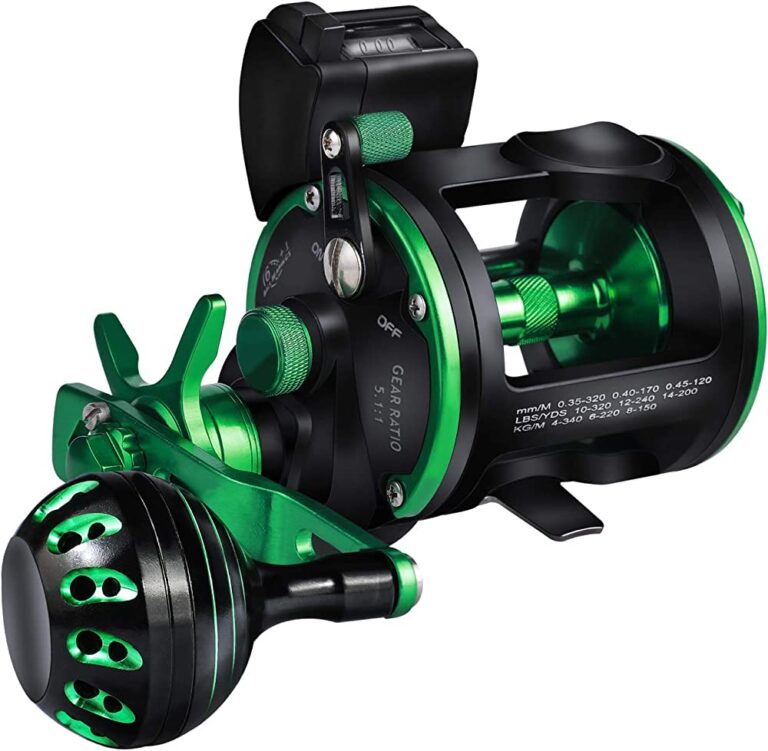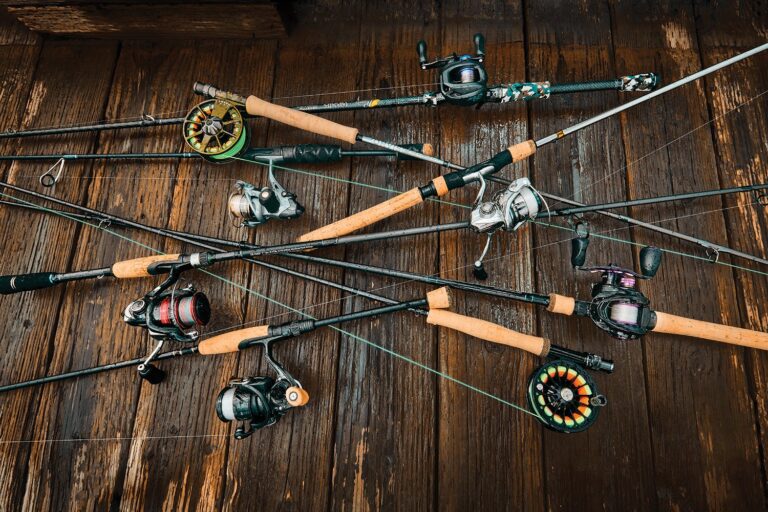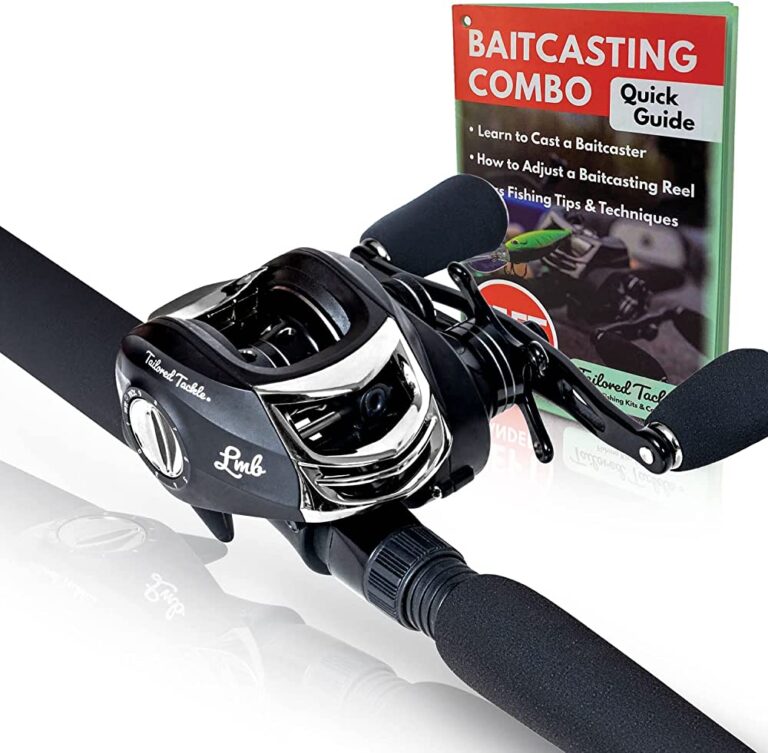To spool a baitcasting reel, thread the line through the reel’s line guide and tie it securely to the spool. Then, engage the reel’s spool tension knob and thumb the spool as you turn the reel handle to evenly distribute the line.
Once the spool is filled to the desired level, adjust the tension knob and test the reel’s casting performance. This technique ensures proper line management and reduces backlash when using a baitcasting reel. Baitcasting reels are popular among fishing enthusiasts for their precision and control.
However, spooling the reel correctly is essential to ensure optimal performance. By following a few simple steps, anglers can effectively spool their baitcasting reel and avoid frustrating tangles or backlash on the water. In this guide, we will outline the process of spooling a baitcasting reel, providing you with the necessary knowledge to get started and improve your fishing experience.

Credit: www.alamy.com
Understanding The Basics Of Baitcasting Reels
Baitcasting reels are popular among experienced anglers for their efficiency and precision in casting and controlling the line. If you’re new to baitcasting reels or simply looking to refresh your knowledge, this section will provide you with a solid understanding of the basics.
What Is A Baitcasting Reel?
A baitcasting reel is a type of fishing reel that sits atop a fishing rod and is designed for casting heavier lures and lines. It utilizes a spool that rotates, allowing the line to be released smoothly during casting while giving the angler precise control over its movement.
Key points about baitcasting reels:
- Designed for casting heavier lures and lines.
- Utilizes a rotating spool for smooth line release.
- Offers greater control and precision during casting.
How Does A Baitcasting Reel Differ From Other Fishing Reels?
While there are various types of fishing reels available, baitcasting reels offer distinct advantages and differences compared to others. Here are the key points to understand about the differences between baitcasting reels and other types:
Key points about baitcasting reels’ differences:
- Baitcasting reels sit atop the fishing rod, whereas spinning reels are mounted beneath.
- Baitcasting reels are better suited for heavier lines and lures, while spinning reels are ideal for lighter tackle.
- The spool of a baitcasting reel rotates during casting, while spinning reels use a fixed spool.
- Baitcasting reels provide greater control and precision, especially for casting accuracy.
- Baitcasting reels have a learning curve for beginners due to the need to control the spool’s release.
Selecting The Right Baitcasting Reel For Optimal Performance
Choosing the right baitcasting reel is crucial for achieving optimal performance and enjoying your fishing experience. Here’s what you should consider when selecting a baitcasting reel:
Key points for selecting the right baitcasting reel:
- Determine the type of fishing you’ll primarily be engaged in (bass fishing, saltwater fishing, etc.) To ensure the reel’s specifications align with your needs.
- Consider the gear ratio of the reel, which determines the speed of line retrieval.
- Pay attention to the drag system of the baitcasting reel, as it influences your ability to control the strength and resistance during a fight with a fish.
- Look for baitcasting reels with adjustable braking systems to enhance your casting accuracy and minimize backlashes.
- Research and compare reviews and ratings of different baitcasting reel models to ensure durability and reliability.
Understanding the basics of baitcasting reels empowers you to make informed decisions when selecting the right reel for your fishing adventures. Keep in mind the unique features and advantages of baitcasting reels, and consider your specific fishing needs when making your choice.
Preparing Your Baitcasting Reel For Spooling
Before you start spooling your baitcasting reel, there are a few important steps you should take to ensure optimal performance. In this section, we will discuss the importance of cleaning and lubricating your reel, choosing the right fishing line, and properly adjusting the reel’s braking system.
The Importance Of Cleaning And Lubricating Your Reel:
- Regular cleaning and lubrication of your baitcasting reel is essential to maintain its longevity and smooth performance.
- Cleaning the reel helps remove any dirt, debris, or corrosion that may have accumulated.
- Lubricating the reel reduces friction and ensures smooth operation of the moving parts.
- Here are a few key points to keep in mind when cleaning and lubricating your baitcasting reel:
- Use a soft cloth or brush to wipe away dirt and debris from the reel’s exterior.
- Remove the side plate(s) to access the internal components of the reel.
- Carefully clean the internal parts using a mild reel cleaner or soapy water.
- Dry the components thoroughly before applying reel oil or grease to the necessary parts.
- Apply the lubricant sparingly to avoid excess buildup, which can attract dirt and grime.
Choosing The Right Fishing Line For Spooling:
- Selecting the appropriate fishing line is crucial for a successful spooling process and efficient casting.
- The fishing line serves as the connection between the reel and the lure, so it’s important to choose the right type and size.
- Consider the following factors when choosing a fishing line:
- Line material: Options include monofilament, fluorocarbon, and braided lines, each with its own strengths and suitable applications.
- Line weight: The pound test rating indicates the strength or thickness of the line, so choose an appropriate weight based on the target species and fishing conditions.
- Line diameter: Thinner lines offer less visibility to fish and allow for longer casts, while thicker lines provide greater strength and durability.
- Line color: Consider the visibility of the line in different water conditions and how it might affect fish behavior.
Properly Adjusting The Reel’S Braking System:
- The braking system on a baitcasting reel helps control the rotation of the spool during a cast, preventing backlash or bird’s nests.
- Proper adjustment of the braking system is essential for smooth casting and efficient line control.
- Here are a few tips to help you adjust the reel’s braking system:
- Consult the reel’s user manual to understand the specific braking system and its adjustment mechanisms.
- Begin by setting the brakes to a medium or neutral position.
- Make test casts and adjust the brake settings incrementally until you find the optimal balance between casting distance and braking force.
- Pay attention to the spool’s rotation speed and adjust the brakes accordingly to minimize backlash.
- Fine-tune the brakes as needed for different lure weights and wind conditions.
By following these guidelines for cleaning and lubricating your reel, choosing the right fishing line, and properly adjusting the braking system, you’ll be well-prepared for spooling your baitcasting reel and enjoying a successful fishing experience.
Step-By-Step Guide To Spooling A Baitcasting Reel
Spooling a baitcasting reel can be a bit tricky, especially for beginners. However, with the right knowledge and techniques, you can easily master this process. In this step-by-step guide, we will walk you through the process of spooling a baitcasting reel, ensuring proper tension and avoiding any line twists or tangles.
Securing The Reel To A Stable Surface
Before you begin spooling your baitcasting reel, it is essential to secure it properly to a stable surface. This will provide stability and make the process much easier. Follow these steps:
- Place the reel seat on a clean and flat surface.
- Ensure that the reel foot is aligned with the reel seat.
- Tighten the reel seat’s locking nut to secure the reel in place.
Attaching The Fishing Line To The Reel
Once you have secured the reel, it’s time to attach the fishing line. Here’s how you can do it effectively:
- Open the bail arm or line guide on the reel.
- Run the fishing line through the line guide and around the spool.
- Make an overhand knot with the tag end of the line and the mainline.
- Tighten the knot by pulling both ends simultaneously.
- Trim any excess line, leaving a small tag for added security.
Spooling The Line Onto The Reel With Proper Tension
Proper tension while spooling the fishing line onto the baitcasting reel is crucial to prevent line slippage. Follow these steps to ensure that you are doing it right:
- Place the line spool on a level and stable surface.
- Apply light pressure with your thumb on the spool to keep tension on the line.
- Engage the reel by turning the handle in the forward direction.
- Maintain gentle tension on the line with your thumb as it spools onto the reel.
- Avoid overfilling the spool to prevent line tangling.
Avoiding Line Twists And Tangles During The Spooling Process
To avoid line twists and tangles while spooling your baitcasting reel, keep the following tips in mind:
- Ensure that the fishing line is feeding onto the reel evenly.
- Occasionally stop the spooling process to inspect the line for twists or tangles.
- If you notice any twists, simply reel the line back onto the spool and start again.
- Maintain consistent tension to prevent any loose line that may result in tangles.
- Regularly check the line for proper spool alignment to minimize tangles.
By following this step-by-step guide, you can effectively spool a baitcasting reel, creating a reliable setup for your fishing adventures. Remember to secure the reel, attach the fishing line correctly, maintain proper tension, and be mindful of line twists and tangles.
With practice, you’ll master the art of spooling a baitcasting reel in no time. Happy fishing!
Pro Tips For Spooling A Baitcasting Reel
Spooling a baitcasting reel can sometimes be a daunting task, especially for beginners. However, with a few pro tips and techniques, you can master the art of spooling your baitcasting reel like a pro. In this section, we will explore some expert advice to ensure a smooth and hassle-free spooling experience.
So, let’s dive in!
Using A Line Conditioner To Enhance Casting Performance
When spooling a baitcasting reel, one of the key factors that contribute to smooth casting is the condition of your fishing line. Using a line conditioner can greatly improve the performance of your baitcasting reel by reducing line memory and increasing line strength.
Here are some important tips to remember:
- Apply a few drops of line conditioner to your fishing line before spooling it onto the reel. This will help to reduce friction, resulting in longer, smoother casts.
- Allow the line conditioner to soak into the line for a few minutes before proceeding with the spooling process. This will ensure that the conditioning properties are fully absorbed.
- Make sure to evenly distribute the line conditioner along the length of the fishing line while spooling. This will help to maximize its effectiveness and provide consistent results.
Adjusting The Reel’S Drag System For Optimal Control
The drag system of a baitcasting reel plays a crucial role in controlling the amount of resistance applied to the fishing line when a fish is hooked. Correctly adjusting the drag system is essential for preventing line breaks and ensuring a successful catch.
Here’s what you need to know:
- Start by setting the drag to a moderate tension. This will provide enough resistance to tire out the fish without risking a line break.
- Gradually increase or decrease the drag tension based on the size and strength of the fish you are targeting. Remember, heavier and more powerful fish require a higher drag setting.
- Test the drag by pulling on the line with gradually increasing force. The line should release smoothly without any sudden jerks. If it feels too loose or too tight, make the necessary adjustments.
Checking And Adjusting The Line Tension Throughout The Spooling Process
Maintaining the proper tension on your fishing line during the spooling process is essential for preventing tangling and ensuring optimal performance. Here are a few tips to help you achieve the perfect line tension:
- Regularly check the line tension as you spool the fishing line onto the reel. Adjust the tension knob or spool control settings accordingly to maintain a consistent and proper line tension.
- Avoid overfilling the reel spool, as it can lead to line tangling and casting issues. Leave a small gap between the line and the spool rim to prevent any potential problems.
- Pay close attention to any signs of line twisting or tangling while spooling. If you notice any issues, stop and address them immediately to avoid future casting problems.
With these pro tips for spooling a baitcasting reel, you’ll be well-equipped to handle the process with confidence. By using a line conditioner, adjusting the drag system, and ensuring proper line tension throughout, you can enhance your casting performance and enjoy a more successful fishing experience.
So, get out there, spool your baitcasting reel like a pro, and reel in those big catches!
Maintaining Your Spooled Baitcasting Reel
So, you’ve learned how to properly spool a baitcasting reel, ensuring a smooth and efficient casting experience. But the work doesn’t end there. To keep your spooled baitcasting reel performing at its best, you need to take proper care of it.
Here are some important tips for maintaining your spooled baitcasting reel:
Proper Storage To Prevent Line Memory And Damage
- Protect your reel from dust and debris by storing it in a reel cover or protective case.
- Avoid extreme temperatures and humidity, as these can lead to damage or line memory.
- Store your reel in a dry and cool place, away from direct sunlight or moisture.
- Hang your reel vertically or lay it flat to maintain proper alignment and prevent warping.
- Regularly inspect your reel for any signs of damage or wear, such as loose screws or cracks.
Regularly Inspecting And Reapplying Lubrication To The Reel
Regular maintenance of your baitcasting reel includes inspecting and lubricating its components. Here are some key points to keep in mind:
- Remove any dirt or debris from the reel using a soft cloth or brush.
- Inspect the handle, spool, brake system, and bearings for any signs of wear or corrosion.
- Apply a small amount of reel oil or lubricant to the moving parts, such as the handle knobs, gears, and bearings.
- Spinning the handle a few times will help distribute the lubricant evenly.
- Avoid over-lubricating, as this can attract dirt and debris.
Replacing The Fishing Line When Necessary To Maintain Performance
Over time, fishing line can become worn out or damaged, affecting your reel’s performance. Here’s what you need to know about replacing the fishing line:
- Inspect the fishing line for any signs of fraying, nicks, or weak spots.
- Replace the line if it shows any signs of damage, as it can lead to breakages during casting or retrieving.
- Follow the manufacturer’s guidelines for selecting the right type and weight of fishing line.
- Use a line spooling station or a friend’s help for smooth and even line winding.
- After replacing the line, adjust the reel’s tension and brake settings to match the new line’s weight and diameter.
By following these maintenance tips, you can prolong the life of your spooled baitcasting reel and ensure optimal performance on your fishing adventures. Regular inspections, lubrication, and timely line replacement will keep your reel in prime condition, ready for action whenever you hit the water.
So, take care of your reel, and it will take care of you in return. Happy fishing!
Troubleshooting Common Issues With Spooling A Baitcasting Reel
Spooling a baitcasting reel is an essential skill for any angler who wants to use this type of reel. However, it can come with its fair share of challenges. In this section, we will look at some common issues that may arise during the spooling process and how to troubleshoot them effectively.
Resolving Backlash Or Bird’S Nest Tangles
One of the most frustrating problems anglers encounter when spooling a baitcasting reel is backlash or bird’s nest tangles. These occur when the line becomes tangled or loops back on itself, making it difficult to cast smoothly. Here are some tips to help you resolve this issue:
- Adjusting the spool tension: Start by loosening the tension knob on the reel. Then, gradually tighten it until the lure falls slowly when the reel is in the free spool position. This will help prevent the line from unraveling too quickly and causing backlash.
- Thumb control: While casting, pay careful attention to your thumb’s position on the spool. Applying slight pressure on the spool with your thumb can help prevent the line from unraveling too quickly and reduce the chances of backlash.
- Practice makes perfect: Backlash is often a result of improper timing or technique. Invest time in practicing your casting skills. With practice, you’ll become more familiar with the reel’s mechanics and learn how to cast smoothly, minimizing the chances of backlash.
Dealing With Line Slipping Or Breaking During Casting
Another common issue anglers face is line slipping or breaking during casting. This can be frustrating, especially when you’re reeling in a potential catch. Here are a few steps to troubleshoot this problem:
- Inspect the line: Before casting, ensure that the line is not damaged or worn out. Weak spots or knots in the line can cause it to slip or break easily. If you notice any issues, it’s best to replace the line before spooling the reel.
- Check the reel’s drag settings: Improperly adjusted drag can cause the line to slip or break during casting. Ensure that the drag settings are appropriate for the type of fish you intend to catch. Adjust the drag using the reel’s drag control knob as necessary.
- Avoid overloading the reel: Overfilling the reel’s spool can cause the line to slip or break. Make sure not to exceed the reel’s recommended line capacity. Leaving some space on the spool will prevent excessive pressure on the line during casting.
Correcting A Stiff Or Uneven Drag System
A stiff or uneven drag system on a baitcasting reel can make it challenging to control the line tension, affecting your ability to reel in a fish smoothly. Here are a few steps to address this issue:
- Clean and lubricate the reel: Dirt, debris, and lack of lubrication can contribute to a stiff drag system. Regularly clean and lubricate the reel to ensure smooth operation. Refer to the reel’s user manual for appropriate cleaning and lubrication instructions.
- Check the drag washers: Drag washers can become compressed or worn, leading to uneven drag performance. Inspect the drag washers for any signs of damage and replace them if necessary. Make sure to use the correct size and type of drag washers recommended by the reel manufacturer.
- Adjust the drag tension: If the drag feels uneven, adjust the drag tension using the reel’s drag control knob. Experiment with different settings until you achieve a smooth, consistent drag feel.
By understanding these common issues and implementing the troubleshooting tips provided, you can enhance your spooling techniques and enjoy a smoother fishing experience with your baitcasting reel. Remember, practice and patience are key to mastering the art of spooling and preventing common glitches along the way.
Conclusion
Spooling a baitcasting reel is an essential skill that every angler should master. By following the step-by-step process outlined in this blog post, you can ensure that your line is properly loaded and ready for a successful day of fishing.
Remember to choose the right type and weight of fishing line for your specific needs, and to use the proper technique when loading it onto your reel. Take your time, be patient, and practice regularly to improve your spooling skills.
With a properly spooled reel, you can cast farther, fight fish more effectively, and avoid frustrating line tangles or breakage. So, go out there and put your newfound spooling knowledge into action on your next fishing trip. Happy spooling and tight lines!




